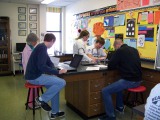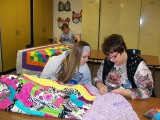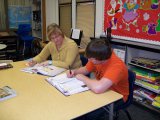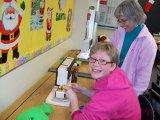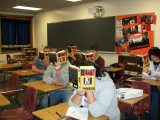-
Category 2
Selected in 2012
-
Grades: 7 - 12
School Setting: rural
Town Population: 1,200
Student Enrollment: 166
Student Demographics:
Black/African American: 1%
Teacher/Student Ratio: 1:9
White/Caucasian: 87%
Hispanic: 3%
Hawaiian/Pacific Islander: 0%
Asian: 1%
Native American: 8%
Other: 0%
% Reduced Lunch: 45%
% ELL Learners: 0%
Founded: 1911 -
PRINCIPAL:
Brandt Gaugler -
CONTACT:
PO Box 368
Beach, ND 58621
701-872-4161
brandt.gaugler@sendit.nodak.edu
Beach High School
Beach, ND
Reading is a priority at Beach High School. We have students enter our school with great diversity in reading levels ranging from 1st through 12th grade. Incoming students are pre-tested in reading to help us obtain a grade level and we post- test to determine student progress in reading. Our main goal is to instill a love of reading in all students, and to improve student achievement in the area of English.
- What is the single most important factor in the success of your school that others could replicate?
- The single most important factor is our variety of supports we have for students and teachers. While we look at school wide patterns we also look at individual student needs and what supports would best benefit each student. These include, but are not limited to, Tutoring, Day Treatment, Building Level Support Team, Supplementary Life Skills Classes, Book Club, and reward systems.
- Describe the program or initiative that has had the greatest positive effect on student achievement.
- Reading is a priority at Beach High School. We have students enter our school with great diversity in reading levels ranging from 1st through 12th grade. Incoming students are pre-tested in reading to help us obtain a grade level and we post- test to determine student progress in reading. Our main goal is to instill a love of reading in all students, and to improve student achievement in the area of English. To encourage the reading, our school requires weekly silent reading in every class. Our Reading Improvement Program, consisting of three reading classes, and a student book club, has been instrumental in helping us reach the goals.
- Explain how Title I funds have supported your improvement efforts.
- Title I funding has allowed us to provide many things. First, our funding allowed us to hire a Reading Teacher. The funds have also been used to purchase the scientifically based STAR Reading and Math assessment, to buy supplementary books for the reading classroom, and to purchase books for a student book club. Those monies have also allowed us to set up two small libraries at Home on the Range so that those students have access to books on weekends, evenings, holiday breaks, and throughout the summer. The school librarian also works closely with the Title staff when purchasing materials and books and planning activities. The reading teacher has attended BER Conferences and State Reading Councils. Title staff has attended State Title Conferences. These professional development opportunities are all possible because of Title funds. Additionally, Ipads and laptops have been purchased with Title funds. This technology allows teachers to implement individualized remedial work with students within the classroom, and has also aided students by keeping current with events, with research, and with collaboration projects. Technologies such as these also allow for real-life reading experiences and practice.
- Describe how data is used to improve student achievement and inform decision making.
- Beach High School uses STAR test results, NWEA test results, State Test results and a weekly review of student D&F list to determine students who would benefit from reading classes. Students are placed in classes according to their reading level abilities. Students are tested at least twice a semester with STAR tests and more often if deemed necessary for student improvement. We test all HOTR students when they enter our school system and then before they exit it. All new students to BHS are tested for reading classes and we look at NWEA and State testing data to determine which incoming 7th grade students should be tested for reading intervention.
- Describe your school culture and explain changes you’ve taken to improve it.
-
We are a small rural 7-12 school, of 175 students, with a unique situation. Nearly 1/3 of our students are residents of Home on the Range (HOTR), a residential treatment center for troubled teens. The residents at HOTR come from varied family, ethnic, and economic backgrounds. They come from cities, small towns, farms, and even other countries. This is rare in a rural school. Another impact upon our school is the oil boom in Southwest North Dakota. We have families entering our district from all over the country. This creates a great challenge for our school because students enter and exit any time during the school year which means we sometimes have very little time to improve a student’s academics. We also face a poverty rate of 45% which also compounds our challenges.
Many of our HOTR students must be integrated gradually into our school system. When students come from HOTR campus they are placed in Day Treatment which is an inclusive program. Here students work on behavior and academics. Using a point reward system they earn their way into the regular classroom setting. Students exit classes one at a time so they can gradually feel comfortable and be successful. The ultimate goal is to assimilate the student into our school culture, where they will succeed academically and socially.
We also have a very active Building Level Support Team (BLST) that is made up of teachers and administrators. BLST is using the Masons Model for At Risk Students. The team creates a behavior plan that aims to improve academics and keep students in school. We also have a weekly D&F list that is printed of all students with Ds and Fs. All students with two or more Fs have a letter sent home to parents and we monitor that student to make sure grades improve.
BHS offers after school tutoring with teachers. We call this RUSH and if a student is struggling, or just needs a quiet place to work, he or she may request a teacher stay with them after school for a half hour. This is especially helpful when students enter the school after the year has started and they need additional help to catch up with the class.
Staff has completed a book study on Dr Ruby Payne’s Understanding Poverty and the school provided an in-service for staff on the book.
Due to the constant entering and exiting of students into our system we have hired a Transition Coordinator. The coordinator works with the student, families, or guardians, and school system where students will be enrolling (or other program such as Job Corps, etc) to ensure the student will have as seamless as possible transition. Hopefully, by preparing the student and the school ahead of time, transitions from BHS will result in continued success and eventual graduation from high school and post-secondary schooling for these students.
Stats
-
Category 2
Selected in 2012
-
Grades: 7 - 12
School Setting: rural
Town Population: 1,200
Student Enrollment: 166
Student Demographics:
Black/African American: 1%
Teacher/Student Ratio: 1:9
White/Caucasian: 87%
Hispanic: 3%
Hawaiian/Pacific Islander: 0%
Asian: 1%
Native American: 8%
Other: 0%
% Reduced Lunch: 45%
% ELL Learners: 0%
Founded: 1911 -
PRINCIPAL:
Brandt Gaugler -
CONTACT:
PO Box 368
Beach, ND 58621
701-872-4161
brandt.gaugler@sendit.nodak.edu


